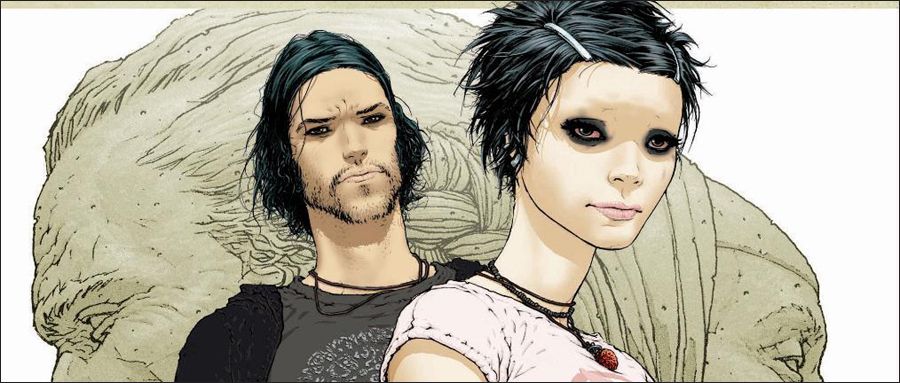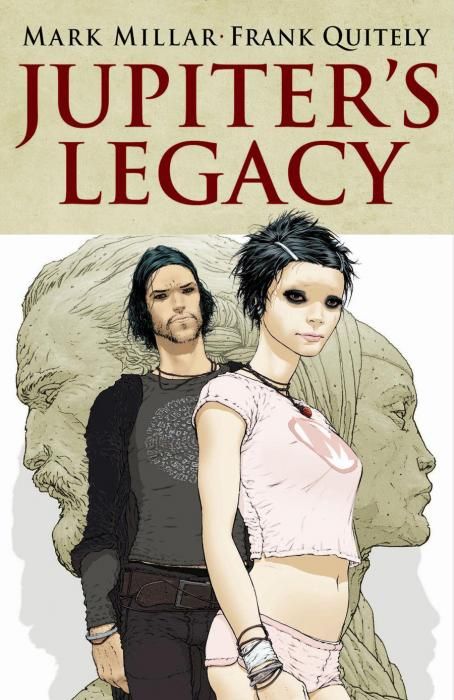The first issue of Jupiter's Legacy -- "This is your summer event," the teaser promised -- arrived this week, setting into motion a multi-generational superhero tale by Mark Millar and Frank Quitely. The duo set a high bar for themselves and superhero comics more than 10 years ago with their work on The Authority. And since then they've each built up quite a resume that includes Ultimates, Kick Ass, All-Star Superman, Wanted, Sandman, Batman & Robin, Civil War and many more. Now the pair re-teams for a creator-owned "superhero event."
"It's very, very much a superhero event. Marvel and DC have their various events this year, and I'm planning on blowing them both away with this," Millar told Comic Book Resources' Kiel Phegley. "I see this as the big creator-owned superhero event. Nobody's tried anything like this before, but it's a big thing covering a huge time period with tons of characters and tons of dramatic twists. Like I said, this is my love letter to America and everything I like about America. America has had its problems, but this is my way of reminding you what's cool about America. It's very timely. This story couldn't have been done five years ago. It's straight out of the headlines of today."
So how does the first issue stack up? Here are a few opinions from around the web:
Melissa Gray, IGN: "Mark Millar proves that he still has his finger on the pulse of popular consciousness with Jupiter’s Legacy #1, a premiere issue that explores superheroics in a way that is both refreshing and cynical. Millar manages to pack a lot of backstory into the first issue without making it feel overcrowded by exposition. The world of Jupiter’s Legacy is both immediately familiar and uniquely original. The theme of incorporating heroes of extraordinary abilities into our world is an ongoing theme Millar explores in his work and nowhere has it struck as strong a chord as it does here." (9.2/10)
Jason Tabrys, Screen Invasion: "Reading like an unfortunate prequel to Kingdom Come, Mark Waid and Alex Ross’ seminal post-superhero epic, with echoes of Grant Morrison’s Zenith character, Jupiter tells the story of a band of heroes who sprung into existence during the great depression, only to birth and raise a new breed of hero that thrives on apathy, stardom, and angst in the modern day. Yes, this is a comic about superhero daddy issues and the crushing pressure of never living up to your parent’s legacy, but its also an over-simplified look at the parallels between the depression and this current period of economic stagnation." (2/5)
David Brothers, ComicsAlliance: "There's a line in the series where the heroes explain that they haven't actually interfered in anything major, like governments and stock markets, and have instead chosen to let humanity chart its own destiny. But if you buy the premise of the series -- 'superheroes won us the war, still exist now, and their kids are dicks' -- then that doesn't work to handwave away the question, does it? The world would be different, vastly different, than the world as we know it. Which really screws with the idea of the series, at least for me. The world we've seen thus far is a reasonable facsimile of our world, only more girls wear booty shorts and more dudes are dicks."
Iann Robinson, Crave Online: "Frank Quitely is the one saving grace here. His artwork, as always, is glorious. I love the kinetic energy behind every panel, the look that everything is moving. Really look at how Quitely pencils a face. He captures the subtlety of movement so well that he brings life to anything on the two dimensional page. His ability to do that with characters simply talking makes his action work off the chart. Quitely’s work is a style, his own unique voice through pictures." (6/10)
Laura Sneddon, The Beat: "Quitely’s work is beautiful, with his panel shifts and viewing angles making the storytelling look deceptively easy. In the incredibly large cast there is never confusion over who is appearing on the page, and personality is expressed wonderfully through facial expressions and body language. Our first hero, Sheldon (The Utopian), has the familiar strong jaw of both Flex and Clark, while the women are beautiful in a more ethereal manner than the pretty but vacant faces that superhero comics are often cursed with."
Greg McElhatton, Comic Book Resources: "Credit also goes to Peter Doherty, whose colors are carefully chosen. I love the limited use of blues and tans for the 1932 sequence, and how as soon as we jump to the present day we get bright reds to immediately jolt us into a more modern era. It's a series of choices that are well-executed, and Doherty's art enhances Quitely's. It's nice to see a pair working so strongly in sync." (4/5)


